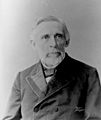Internal Revenue Service facts for kids
| IRS | |
 |
|
| Agency overview | |
|---|---|
| Formed | July 1, 1862 (though the name originates from 1918) |
| Jurisdiction | Federal government of the United States |
| Headquarters | Internal Revenue Service Building 1111 Constitution Ave., NW; Washington, DC 20224,U.S |
| Employees | 79,890 (2015) |
| Annual budget | $11.4 billion (2015) |
| Agency executive |
|
| Parent agency | Department of the Treasury |
The Internal Revenue Service (IRS) is a very important part of the Federal government of the United States. Its main job is to collect taxes from people and businesses. It also makes sure that everyone follows the tax laws.
The IRS figures out how much tax is owed. Then, it collects this money regularly. The IRS is the biggest office within the United States Department of the Treasury. It is known as one of the most effective tax collection groups in the world. For example, in 2004, the IRS handled over 224 million tax forms. It collected more than $2 trillion in money for the government.
Contents
How the IRS Started: A Look at Its History
Early Taxes in the United States
In 1791, the U.S. federal government started collecting money through taxes. These taxes were on things like alcoholic drinks, tobacco, and sugar. These were called indirect taxes. This means the tax was included in the price of goods. The U.S. Constitution only allowed these types of taxes at first.
Later, in 1812, the country needed more money for a war. So, the government added the first sales taxes. These were on items like gold, jewelry, and silverware. However, by 1817, all these taxes were removed. The government then relied on money from tariffs. Tariffs are taxes on imported goods coming into the country.
The First Income Tax
During the American Civil War, the government needed a lot of money to pay for the war. In 1861, Congress tried to create a new type of tax. This was a direct tax on what people and companies earned, called an income tax.
The first income tax plan suggested a 3% tax on incomes over $800. This bill passed Congress but was never put into action. However, in 1862, President Abraham Lincoln signed a new bill. This bill created a tax of 3% on incomes between $600 and $5,000. Higher incomes had higher tax rates. There were many discussions about whether this direct income tax was allowed by the Constitution. But no changes were made. This tax ended in 1872 and was not renewed.
The Commissioner of Internal Revenue
In 1862, Congress also created the office of the Commissioner of Internal Revenue. This person had the power to figure out, charge, and collect taxes. They could also make sure tax laws were followed. This included taking legal action or seizing property if needed. George S. Boutwell was the very first Commissioner of the Bureau of Internal Revenue.
Income Tax Returns and the Supreme Court
In 1894, Congress passed a law that lowered taxes on some imported goods. To make up for this, they added a 2% direct income tax. But a year later, the Supreme Court said this income tax was against the Constitution. In a case called Pollock v. Farmers' Loan & Trust Co, the Court ruled that the Constitution did not allow an income tax unless it was divided fairly among the states. This was a big problem for collecting income taxes.
The Sixteenth Amendment and Modern IRS
On February 3, 1913, something very important happened. The Sixteenth Amendment to the United States Constitution was approved. This amendment changed the Constitution. It allowed Congress to collect an income tax without having to divide it among the states. This solved the problem the Supreme Court had pointed out.
After this, the Bureau of the IRS was put in charge of collecting income taxes. The first personal income tax was 1% on income above $3,000. Higher incomes had an extra 6% tax. During World War I, income taxes went up a lot, as high as 77% in 1918, to help pay for the war. After the war, they dropped. But they rose again during the Great Depression in 1929. During World War II, new ways of collecting taxes were started, like taking taxes directly from paychecks.
In 1953, the Bureau of Internal Revenue changed its name. It became what we know today: the Internal Revenue Service. In 1998, a new law called the IRS Restructuring and Reform Act further updated the agency. It also gave more rights to taxpayers.
Images for kids
-
Internal Revenue Service Building on Constitution Avenue in Washington, D.C.
-
George S. Boutwell was the first Commissioner of Internal Revenue under President Abraham Lincoln.
-
New York City field office for the IRS.
See also
 In Spanish: Servicio de Impuestos Internos de los Estados Unidos para niños
In Spanish: Servicio de Impuestos Internos de los Estados Unidos para niños









